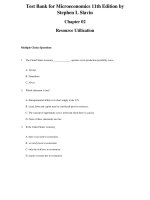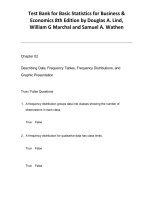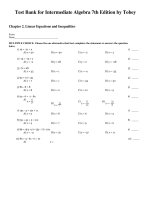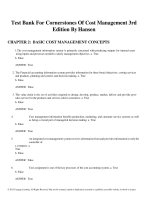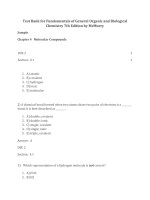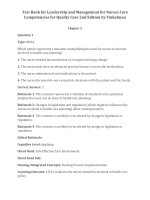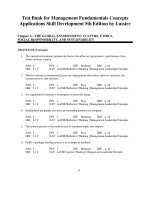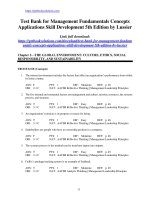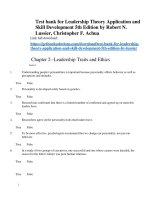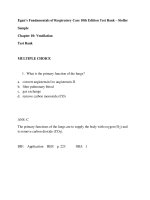link full download test bank for management fundamentals concepts applications skill development 5th edition by lussier
Bạn đang xem bản rút gọn của tài liệu. Xem và tải ngay bản đầy đủ của tài liệu tại đây (421.37 KB, 36 trang )
Test Bank for Management Fundamentals Concepts
Applications Skill Development 5th Edition by Lussier
Chapter 2—THE GLOBAL ENVIRONMENT: CULTURE, ETHICS,
SOCIAL RESPONSIBILITY, AND SUSTAINABILITY
TRUE/FALSE (Concepts)
1. The internal environment includes the factors that affect an organization’s performance from
within its home country.
ANS: F
OBJ: 2-1 C
PTS: 1
DIF: Moderate
REF: p. 48
NAT: AACSB Reflective Thinking | Management Leadership Principles
2. The five internal environmental factors are management and culture, mission, resources, the
systems process, and structure.
ANS: T
OBJ: 2-1 C
PTS: 1
DIF: Easy
REF: p. 48
NAT: AACSB Reflective Thinking | Management Leadership Principles
3. An organization’s mission is its purpose or reason for being.
ANS: T
OBJ: 2-1 C
PTS: 1
DIF: Easy
REF: p. 48
NAT: AACSB Reflective Thinking | Management Leadership Principles
4. Stakeholders are people who have an ownership position in a company.
ANS: F
OBJ: 2-1 C
PTS: 1
DIF: Moderate
REF: p. 48
NAT: AACSB Reflective Thinking | Management Leadership Principles
5. The systems process is the method used to transform inputs into outputs.
ANS: T
OBJ: 2-1 C
PTS: 1
DIF: Easy
REF: p. 49
NAT: AACSB Reflective Thinking | Management Leadership Principles
6. FedEx’s package tracking system is an example of feedback.
ANS: T
OBJ: 2-1 C
PTS: 1
DIF: Moderate
REF: p. 49
NAT: AACSB Analytic Thinking | Management Leadership Principles
33
7. Quality is determined by comparing a product’s actual functioning to their requirements to
determine value.
ANS: T
OBJ: 2-1 C
PTS: 1
DIF: Hard
REF: pp. 49-50
NAT: AACSB Reflective Thinking | Management Leadership Principles
8. Customer value is the perceived benefit of a product, used by customers to determine whether or
not to buy the product.
ANS: T
OBJ: 2-1 C
PTS: 1
DIF: Moderate
REF: p. 50
NAT: AACSB Reflective Thinking | Management Leadership Principles
9. Total quality management (TQM) is the process that involves managers in an organization
focusing on the customer to continually improve product value.
ANS: F
OBJ: 2-2 C
PTS: 1
DIF: Hard
REF: p. 50
NAT: AACSB Reflective Thinking | Management Leadership Principles
10. “Focusing on delivering customer value” and “continually improving the system and its
processes” are the two primary principles of total quality management (TQM).
ANS: T
OBJ: 2-2 C
PTS: 1
DIF: Moderate
REF: p. 50
NAT: AACSB Reflective Thinking | Management Leadership Principles
11. Fostering the right organizational culture is one of the most important responsibilities of a firstline manager.
ANS: F
OBJ: 2-3 C
PTS: 1
DIF: Moderate
REF: p. 52
NAT: AACSB Reflective Thinking | Management Leadership Principles
12. Organizational stories about company founders seldom impact the corporate culture.
ANS: F
OBJ: 2-3 C
PTS: 1
DIF: Easy
REF: p. 52
NAT: AACSB Reflective Thinking | Management Leadership Principles
13. McDonald’s slogan, “Q, S, C, V” is an example of how employees learn about organizational
culture.
ANS: T
OBJ: 2-3 C
PTS: 1
DIF: Moderate
REF: p. 52
NAT: AACSB Analytic Thinking | Management Leadership Principles
14. Heroes, stories, slogans, symbols, and ceremonies are all part of behavior-level culture.
ANS: T
OBJ: 2-3 C
PTS: 1
DIF: Moderate
REF: p. 52
NAT: AACSB Reflective Thinking | Management Leadership Principles
15. Values and beliefs are often the most stable and enduring part of culture.
ANS: F
OBJ: 2-3 C
PTS: 1
DIF: Hard
REF: p. 53
NAT: AACSB Reflective Thinking | Management Leadership Principles
16. Organizations with strong cultures have employees who consciously know the shared values and
beliefs and behave as expected.
ANS: T
OBJ: 2-3 C
PTS: 1
DIF: Moderate
REF: p. 53
NAT: AACSB Reflective Thinking | Management Leadership Principles
17. A learning organization has a culture that values sharing knowledge so as to adapt to the changing
environment and continually improve.
ANS: T
OBJ: 2-3 C
PTS: 1
DIF: Moderate
REF: p. 55
NAT: AACSB Reflective Thinking | Management Leadership Principles
18. The organization’s external environment includes the factors outside its boundaries that affect
its performance.
ANS: T
OBJ: 2-4 C
PTS: 1
DIF: Easy
REF: p. 56
NAT: AACSB Reflective Thinking | Management Environmental Influence
19. Customers, competition, suppliers, labor force, shareholders, society, technology, the
systems process, and governments are the factors which comprise the external environment.
ANS: F
OBJ: 2-4 C
PTS: 1
DIF: Hard
REF: p. 56
NAT: AACSB Reflective Thinking | Management Environmental Influence
20. As a business grows, the complexity of its internal and external environments increases.
ANS: T
OBJ: 2-4 C
PTS: 1
DIF: Moderate
REF: p. 58
NAT: AACSB Reflective Thinking | Management Environmental Influence
21. Ethnocentrism means seeing things solely from one’s own perspective.
ANS: F
OBJ: 2-4 C
PTS: 1
DIF: Moderate
REF: p. 59
NAT: AACSB Reflective Thinking | Management Environmental Influence
22. When the dollar is weak, foreign goods are less expensive in the United States.
ANS: F
OBJ: 2-4 C
PTS: 1
DIF: Hard
REF: p. 61
NAT: AACSB Analytic Thinking | Management Environmental Influence
23. The World Trade Organization (WTO) establishes and enforces world trade laws.
ANS: T
OBJ: 2-4 C
PTS: 1
DIF: Easy
REF: p. 61
NAT: AACSB Reflective Thinking | Management Environmental Influence
24. The North American Free Trade Agreement (NAFTA) called for immediately eliminating duties
on the majority of tariffs on products traded among the United States, Canada, and Europe.
ANS: F
OBJ: 2-4 C
PTS: 1
DIF: Easy
REF: p. 62
NAT: AACSB Reflective Thinking | Management Environmental Influence
25. A domestic business conducts business in only one country.
ANS: T
OBJ: 2-5 C
PTS: 1
DIF: Moderate
REF: p. 63
NAT: AACSB Diversity | Management Environmental Influence
26. An international business has significant operations in more than one country.
ANS: F
OBJ: 2-5 C
PTS: 1
DIF: Moderate
REF: p. 63
NAT: AACSB Diversity | Management Environmental Influence
27. A multinational corporation (MNC) has significant operations in more than one country.
ANS: T
OBJ: 2-5 C
PTS: 1
DIF: Moderate
REF: p. 63
NAT: AACSB Diversity | Management Environmental Influence
28. Importing and exporting is the lowest-risk way to take a business global, whereas direct
investment is the highest-risk way to take a business global.
ANS: T
OBJ: 2-6 C
PTS: 1
DIF: Moderate
REF: p. 63
NAT: AACSB Diversity | Management Environmental Influence
29. Global sourcing is the use of worldwide resources.
ANS: T
OBJ: 2-6 C
PTS: 1
DIF: Easy
REF: p. 63
NAT: AACSB Diversity | Management Environmental Influence
30. A joint venture is created when one company hires another to help provide a new product/service.
ANS: F
OBJ: 2-6 C
31.
PTS: 1
DIF: Moderate
REF: p. 64
NAT: AACSB Diversity | Management Environmental Influence
Direct investment occurs when a company buys back shares of its own stock on the open market.
ANS: F
OBJ: 2-6 C
PTS: 1
DIF: Hard
REF: p. 65
NAT: AACSB Diversity | Management Environmental Influence
32. Many small business owners turn to the Ex-Im Bank when they are ready to go global.
ANS: T
OBJ: 2-6 C
PTS: 1
DIF: Hard
REF: p. 66
NAT: AACSB Diversity | Management Environmental Influence
33. As a global manager, you should expect new employees to adapt to your home culture and ways
of doing things.
ANS: F
OBJ: 2-6 C
PTS: 1
DIF: Moderate
REF: p. 67
NAT: AACSB Diversity | Management Environmental Influence
34. Ethics are the standards of right and wrong that influence behavior.
ANS: T
OBJ: 2-7 C
PTS: 1
DIF: Easy
REF: p. 69
NAT: AACSB Ethics | Management Ethical Responsibilities
35. Moral development refers to distinguishing right from wrong and choosing to do the right thing.
ANS: T
OBJ: 2-7 C
PTS: 1
DIF: Easy
REF: p. 69
NAT: AACSB Ethics | Management Ethical Responsibilities
36. At the preconventional level of moral development, behavior is motivated by the desire to live up
to others’ expectations.
ANS: F
OBJ: 2-7 C
PTS: 1
DIF: Easy
REF: p. 71
NAT: AACSB Ethics | Management Ethical Responsibilities
37. Leaders at the preconventional level of moral development often are autocratic toward others.
ANS: T
OBJ: 2-7 C
PTS: 1
DIF: Easy
REF: p. 71
NAT: AACSB Ethics | Management Ethical Responsibilities
38. At the conventional level of moral development, behavior is motivated by universal principles
of right and wrong, regardless of the expectations of leaders or one’s group.
ANS: F
OBJ: 2-7 C
PTS: 1
DIF: Easy
REF: p. 71
NAT: AACSB Ethics | Management Ethical Responsibilities
39. Leaders at the conventional level of moral development tend to be visionary.
ANS: F
OBJ: 2-7 C
PTS: 1
DIF: Easy
REF: p. 71
NAT: AACSB Ethics | Management Ethical Responsibilities
40. At the postconventional level of moral development, self-interest motivates behavior.
ANS: T
OBJ: 2-7 C
PTS: 1
DIF: Easy
REF: p. 71
NAT: AACSB Ethics | Management Ethical Responsibilities
41. Leaders at the postconventional level of moral development tend to use a leadership style similar
to those of higher-level managers.
ANS: F
OBJ: 2-7 C
PTS: 1
DIF: Easy
REF: p. 71
NAT: AACSB Ethics | Management Ethical Responsibilities
42. The stakeholders’ approach to ethics is deciding which stakeholders have the most influence
and then catering to them.
ANS: F
OBJ: 2-8 C
PTS: 1
DIF: Moderate
REF: p. 73
NAT: AACSB Ethics | Management Ethical Responsibilities
43. The stakeholders’ approach to ethics involves creating a win-win situation for all relevant
stakeholders so that everyone benefits from the decision.
ANS: T
OBJ: 2-8 C
PTS: 1
DIF: Moderate
REF: p. 73
NAT: AACSB Ethics | Management Ethical Responsibilities
44. Codes of ethics state the importance of conducting business in an ethical manner and provide
guidelines for ethical behavior.
ANS: T
OBJ: 2-8 C
PTS: 1
DIF: Easy
REF: p. 74
NAT: AACSB Ethics | Management Ethical Responsibilities
45. Whistle-blowing occurs when employees expose what they believe to be unethical behavior by
their fellow employees.
ANS: T
OBJ: 2-8 C
PTS: 1
DIF: Easy
REF: p. 74
NAT: AACSB Ethics | Management Ethical Responsibilities
46. Whistle-blowing should begin externally, and information should go up the chain of command.
ANS: F
OBJ: 2-8 C
PTS: 1
DIF: Easy
REF: p. 74
NAT: AACSB Ethics | Management Ethical Responsibilities
47. Social responsibility is the conscious effort to operate in a manner that creates a win-win
situation for all stakeholders.
ANS: T
OBJ: 2-8 C
PTS: 1
DIF: Easy
REF: p. 74
NAT: AACSB Ethics | Management Ethical Responsibilities
48. A social audit is a measure of a firm’s social behavior.
ANS: T
OBJ: 2-8 C
PTS: 1
DIF: Easy
REF: p. 76
NAT: AACSB Ethics | Management Ethical Responsibilities
49. Sustainability is meeting the needs of future generations without compromising the ability of the
present world to meet their own needs.
ANS: F
OBJ: 2-8 C
PTS: 1
DIF: Moderate
REF: p. 76
NAT: AACSB Ethics | Management Ethical Responsibilities
50. A green company acts in a way that minimizes damage to the environment.
ANS: T
OBJ: 2-8 C
PTS: 1
DIF: Easy
REF: p. 77
NAT: AACSB Ethics | Management Ethical Responsibilities
MULTIPLE CHOICE (Concepts)
1. All of the following are internal environmental factors EXCEPT:
a. management and culture.
b. mission.
c. resources.
d. competition.
ANS: D
OBJ: 2-1 C
PTS: 1
DIF: Moderate
REF: p. 48
NAT: AACSB Reflective Thinking | Management Leadership Principles
2. The five internal environmental factors are:
a. management and culture, mission, resources, the systems process, and structure.
b. management and culture, mission, people, the systems process, and structure.
c. management and culture, mission, people, resources, and structure.
d. management and culture, mission, resources, the control systems, and structure.
ANS: A
OBJ: 2-1 C
PTS: 1
DIF: Hard
REF: p. 48
NAT: AACSB Reflective Thinking | Management Leadership Principles
3. An organization’s mission is its:
a. purpose or reason for being.
b. human and informational inputs.
c. method used to transform inputs into outputs.
d. grouping of resources.
ANS: A
OBJ: 2-1 C
PTS: 1
DIF: Moderate
REF: p. 48
NAT: AACSB Reflective Thinking | Management Leadership Principles
4. All of the following are true regarding the organization’s mission EXCEPT:
a. it is the organization’s reason for being.
b. developing it is the responsibility of first-line management.
c. it should be relevant to all stakeholders.
d. it is an expression of the ends the organization strives to attain.
ANS: B
OBJ: 2-1 C
PTS: 1
DIF: Moderate
REF: p. 48
NAT: AACSB Reflective Thinking | Management Leadership Principles
5. Stakeholders are:
a. people with an ownership position in the business.
b. government regulators who must regulate the business.
c. people whose interests are affected by organizational behavior.
d. people not affected by organizational behavior.
ANS: C
OBJ: 2-1 C
PTS: 1
DIF: Moderate
REF: p. 48
NAT: AACSB Reflective Thinking | Management Leadership Principles
6. __________ is the method used to transform inputs into outputs.
a. Quality
b. The systems process
c. Customer value
d. Structure
ANS: B
OBJ: 2-1 C
PTS: 1
DIF: Easy
REF: p. 49
NAT: AACSB Reflective Thinking | Management Leadership Principles
7. Which of the following is NOT a component of the systems process?
a. feedback
b. transformation
c. quality
d. inputs
ANS: C
OBJ: 2-1 C
PTS: 1
DIF: Moderate
REF: p. 49
NAT: AACSB Reflective Thinking | Management Leadership Principles
8. Customer value is:
a. comparing a product’s actual functioning to their requirements to determine value.
b. the process that involves everyone in the organization focusing on the customer
to continually improve product value.
c. the method used to transform inputs into outputs.
d. the perceived benefit of a product, used by customers to determine whether or not to buy
the product.
ANS: D
OBJ: 2-1 C
PTS: 1
DIF: Hard
REF: p. 50
NAT: AACSB Reflective Thinking | Management Leadership Principles
9. Total quality management (TQM) is:
a. comparing a product’s actual functioning to their requirements to determine value.
b. the process that involves everyone in the organization focusing on the customer
to continually improve product value.
c. the method used to transform inputs into outputs.
d. the perceived benefit of a product, used by customers to determine whether or not to buy
the product.
ANS: B
OBJ: 2-2 C
PTS: 1
DIF: Moderate
REF: p. 50
NAT: AACSB Reflective Thinking | Management Leadership Principles
10. The two primary principles of total quality management (TQM) are:
a. focusing on delivering customer value and focusing on managing processes rather
than people.
b. focusing on managing processes rather than people and working in teams to
execute processes efficiently and effectively.
c. focusing on delivering customer value and continually improving the system and
its processes.
d. focusing on managing processes rather than people and continually improving the system
and its processes.
ANS: C
OBJ: 2-2 C
PTS: 1
DIF: Moderate
REF: p. 50
NAT: AACSB Reflective Thinking | Management Leadership Principles
11. Structure refers to:
a. an organization’s purpose or reason for being.
b. the values, beliefs, and assumptions about appropriate behavior that members of
an organization share.
c. the ends the organization strives to attain.
d. the way in which an organization groups its resources to accomplish its mission.
ANS: D
OBJ: 2-2 C
PTS: 1
DIF: Moderate
REF: p. 50
NAT: AACSB Reflective Thinking | Management Leadership Principles
12. Which of the following is NOT a level of culture?
a. assumptions
b. values and beliefs
c. ethics
d. behavior
ANS: C
OBJ: 2-3 C
PTS: 1
DIF: Easy
REF: p. 52
NAT: AACSB Reflective Thinking | Management Leadership Principles
13. A __________ organization has a culture that values sharing knowledge so as to adapt to the
changing environment and continuously improve.
a. strong
b. weak
c. learning
d. knowledge
ANS: C
OBJ: 2-3 C
PTS: 1
DIF: Moderate
REF: p. 55
NAT: AACSB Reflective Thinking | Management Leadership Principles
14. Which of the following is NOT an element of a learning organization?
a. open information
b. a strong adaptive culture
c. a participative strategy
d. autocratic leadership
ANS: D
OBJ: 2-3 C
PTS: 1
DIF: Easy
REF: p. 55
NAT: AACSB Reflective Thinking | Management Leadership Principles
15. All of the following are external environmental factors EXCEPT:
a. customers.
b. competition.
c. the systems process.
d. suppliers.
ANS: C
OBJ: 2-4 C
PTS: 1
DIF: Moderate
REF: p. 56
NAT: AACSB Reflective Thinking | Management Environmental Influence
16. In an organization’s external environment, task factors include all of the following EXCEPT:
a. customers.
b. competition.
c. suppliers.
d. the economy.
ANS: D
OBJ: 2-4 C
PTS: 1
DIF: Hard
REF: p. 56
NAT: AACSB Reflective Thinking | Management Environmental Influence
17. In an organization’s external environment, general factors include all of the following EXCEPT:
a. governments.
b. technology.
c. labor force.
d. society.
ANS: C
OBJ: 2-4 C
PTS: 1
DIF: Hard
REF: p. 56
NAT: AACSB Reflective Thinking | Management Environmental Influence
18. In many industries, the environment is changing at such an incredibly fast pace that it is commonly
referred to as being “in chaos.” The type of manager who can thrive in such an environment is
called a(n) __________ manager.
a. reactive
b. responsive
c. interactive
d. chaotic
ANS: C
OBJ: 2-4 C
PTS: 1
DIF: Moderate
REF: p. 58
NAT: AACSB Reflective Thinking | Management Environmental Influence
19. __________ refers to companies conducting business worldwide without boundaries.
a. Ethnocentrism
b. International business
c. The global village
d. A joint venture
ANS: C
OBJ: 2-4 C
PTS: 1
DIF: Moderate
REF: p. 59
NAT: AACSB Reflective Thinking | Management Environmental Influence
20. Regarding one’s own ethnic group or culture as superior to others is known as:
a. parochialism.
b. ethnocentrism.
c. the global village.
d. none of these
ANS: B
OBJ: 2-4 C
PTS: 1
DIF: Moderate
REF: p. 59
NAT: AACSB Reflective Thinking | Management Environmental Influence
21. The __________ is the difference between the value of the products (including services) that
a country exports and the trade of the products it imports.
a. trade surplus
b. trade deficit
c. balance of trade
d. exchange rate
ANS: C
OBJ: 2-4 C
PTS: 1
DIF: Moderate
REF: p. 60
NAT: AACSB Reflective Thinking | Management Environmental Influence
22. You’re selling a product in Finland for 200 euros with an exchange rate of .80 euros to 1 dollar.
If the exchange rate changes to .90 euros to 1 dollar,:
a. you get more money for your product.
b. you get less money for your product.
c. your product’s price automatically changes.
d. none of these
ANS: B
OBJ: 2-4 C
PTS: 1
DIF: Hard
REF: p. 61
NAT: AACSB Reflective Thinking | Management Environmental Influence
23. All of the following are primary protection methods in a global environment EXCEPT:
a. tariffs.
b. dumping.
c. quotas.
d. embargoes.
ANS: B
OBJ: 2-4 C
PTS: 1
DIF: Moderate
REF: p. 61
NAT: AACSB Reflective Thinking | Management Environmental Influence
24. The __________ is the single European currency that makes conducting business and
traveling much easier in the European Union.
a. franc
b. mark
c. euro
d. none of these
ANS: C
OBJ: 2-4 C
PTS: 1
DIF: Easy
REF: p. 62
NAT: AACSB Reflective Thinking | Management Environmental Influence
25. A business based primarily in one country that transacts business in other countries is a(n):
a. international business.
b. multinational corporation.
c. global business.
d. worldwide business.
ANS: A
OBJ: 2-5 C
PTS: 1
DIF: Moderate
REF: p. 63
NAT: AACSB Diversity | Management Environmental Influence
26. A business with significant operations in more than one country is a(n):
a. international business.
b. multinational corporation.
c. global business.
d. worldwide business.
ANS: B
OBJ: 2-5 C
PTS: 1
DIF: Moderate
REF: p. 63
NAT: AACSB Diversity | Management Environmental Influence
27. All of the following are ways to take a business global EXCEPT:
a. global sourcing.
b. importing and exporting.
c. licensing.
d. global advertising.
ANS: D
OBJ: 2-6 C
PTS: 1
DIF: Moderate
REF: p. 63
NAT: AACSB Diversity | Management Environmental Influence
28. Global sourcing is:
a. selling products in other countries.
b. obtaining resources from other countries.
c. the use of worldwide resources.
d. hiring people from other countries.
ANS: C
OBJ: 2-6 C
PTS: 1
DIF: Moderate
REF: p. 63
NAT: AACSB Diversity | Management Environmental Influence
29. With __________, one company allows another to use its assets (intellectual property), such as
a brand name, a trademark, a particular technology, a patent, or a copyright.
a. a joint venture
b. direct investment
c. contract manufacturing
d. licensing
ANS: D
OBJ: 2-6 C
PTS: 1
DIF: Easy
REF: p. 64
NAT: AACSB Diversity | Management Environmental Influence
30. With __________, a company has a foreign firm manufacture the goods that it sells as its own.
a. a joint venture
b. direct investment
c. contract manufacturing
d. licensing
ANS: C
OBJ: 2-6 C
PTS: 1
DIF: Easy
REF: p. 64
NAT: AACSB Diversity | Management Environmental Influence
31. A(n) __________ is created when firms share ownership of a new enterprise.
a. conglomerate
b. corporation
c. international business
d. joint venture
ANS: D
OBJ: 2-6 C
PTS: 1
DIF: Moderate
REF: p. 64
NAT: AACSB Diversity | Management Environmental Influence
32. __________ is the construction or purchase of operating facilities (subsidiaries) in a
foreign country.
a. A joint venture
b. Direct investment
c. Contract manufacturing
d. A conglomerate
ANS: B
OBJ: 2-6 C
PTS: 1
DIF: Moderate
REF: p. 65
NAT: AACSB Diversity | Management Environmental Influence
33. Which of the following is the most common small business global strategy?
a. importing and exporting
b. joint ventures
c. strategic alliances
d. direct investment
ANS: A
OBJ: 2-6 C
PTS: 1
DIF: Hard
REF: p. 65
NAT: AACSB Diversity | Management Environmental Influence
34. Which of the following countries would rank the highest in the GLOBE dimension of
gender differences?
a. Denmark
b. Italy
c. United States
d. China
ANS: D
OBJ: 2-6 C
PTS: 1
DIF: Hard
REF: p. 68
NAT: AACSB Diversity | Management Environmental Influence
35. Which of the following countries would rank the highest in the GLOBE dimension of
performance orientation?
a. Russia
b. United States
c. England
d. Denmark
ANS: B
OBJ: 2-6 C
PTS: 1
DIF: Hard
REF: p. 68
NAT: AACSB Diversity | Management Environmental Influence
36. Ethics is defined as:
a. the standards of right and wrong that influence behavior.
b. creating a win-win situation for all stakeholders.
c. adhering to legal limits.
d. what top management thinks is right.
ANS: A
OBJ: 2-7 C
PTS: 1
DIF: Easy
REF: p. 69
NAT: AACSB Ethics | Management Ethical Responsibilities
37. __________ refers to distinguishing right from wrong and choosing to do the right thing.
a. Personality
b. Moral development
c. Ethics
d. Social responsibility
ANS: B
OBJ: 2-7 C
PTS: 1
DIF: Moderate
REF: p. 69
NAT: AACSB Ethics | Management Ethical Responsibilities
38. At the preconventional level of moral development, behavior is motivated by:
a. the desire to live up to others’ expectations.
b. universal principles of right and wrong.
c. self-interest.
d. personality.
ANS: C
OBJ: 2-7 C
PTS: 1
DIF: Moderate
REF: p. 71
NAT: AACSB Ethics | Management Ethical Responsibilities
39. Leaders at the preconventional level of moral development tend to:
a. be autocratic toward others.
b. use a leadership style similar to those of higher-level managers.
c. be visionary.
d. be committed to serving others.
ANS: A
OBJ: 2-7 C
PTS: 1
DIF: Moderate
REF: p. 71
NAT: AACSB Ethics | Management Ethical Responsibilities
40. At the conventional level of moral development, behavior is motivated by:
a. the desire to live up to others’ expectations.
b. universal principles of right and wrong.
c. self-interest.
d. personality.
ANS: A
OBJ: 2-7 C
PTS: 1
DIF: Moderate
REF: p. 71
NAT: AACSB Ethics | Management Ethical Responsibilities
41. Leaders at the conventional level of moral development tend to:
a. use their position to gain personal advantages.
b. use a leadership style similar to those of higher-level managers.
c. be visionary.
d. be committed to serving others.
ANS: B
OBJ: 2-7 C
PTS: 1
DIF: Moderate
REF: p. 71
NAT: AACSB Ethics | Management Ethical Responsibilities
42. At the postconventional level of moral development, behavior is motivated by:
a. the desire to live up to others’ expectations.
b. universal principles of right and wrong.
c. self-interest.
d. personality.
ANS: B
OBJ: 2-7 C
PTS: 1
DIF: Moderate
REF: p. 71
NAT: AACSB Ethics | Management Ethical Responsibilities
43. Leaders at the postconventional level of moral development tend to:
a. be autocratic toward others.
b. use a leadership style similar to those of higher-level managers.
c. be visionary.
d. use their position to gain personal advantages.
ANS: C
OBJ: 2-7 C
PTS: 1
DIF: Moderate
REF: p. 71
NAT: AACSB Ethics | Management Ethical Responsibilities
44. When we behave unethically, we often justify the behavior to protect our __________ so that
we don’t have a guilty conscience or feel remorse.
a. personality
b. ego
c. self-concept
d. job
ANS: C
OBJ: 2-7 C
PTS: 1
DIF: Easy
REF: p. 72
NAT: AACSB Ethics | Management Ethical Responsibilities
45. People at the preconventional and conventional levels of moral development might use all of
the following justifications for unethical behavior EXCEPT:
a. displacement of responsibility.
b. diffusion of responsibility.
c. the Four-Way Test.
d. advantageous comparison.
ANS: C
OBJ: 2-7 C
PTS: 1
DIF: Easy
REF: p. 72
NAT: AACSB Ethics | Management Ethical Responsibilities
46. __________ is the process of claiming unethical behavior was caused by someone else’s behavior.
a. Diffusion of responsibility
b. Attribution of blame
c. Euphemistic labeling
d. Displacement of responsibility
ANS: B
OBJ: 2-7 C
PTS: 1
DIF: Moderate
REF: p. 72
NAT: AACSB Ethics | Management Ethical Responsibilities
47. Creating a win-win situation for all relevant stakeholders so that everyone benefits from the
decision is known as:
a. ethics.
b. morality.
c. a compromise.
d. the stakeholders’ approach to ethics.
ANS: D
OBJ: 2-8 C
PTS: 1
DIF: Moderate
REF: p. 73
NAT: AACSB Ethics | Management Ethical Responsibilities
48. __________ states the importance of conducting business in an ethical manner and
provides guidelines for ethical behavior.
a. Social responsibility
b. A social audit
c. A code of ethics
d. The stakeholders’ approach to ethics
ANS: C
OBJ: 2-8 C
PTS: 1
DIF: Easy
REF: p. 74
NAT: AACSB Ethics | Management Ethical Responsibilities
49. __________ occurs when employees expose what they believe to be unethical behavior by their
fellow employees.
a. Social responsibility
b. A social audit
c. A code of ethics
d. Whistle-blowing
ANS: D
OBJ: 2-8 C
PTS: 1
DIF: Easy
REF: p. 74
NAT: AACSB Ethics | Management Ethical Responsibilities
50. The conscious effort to operate in a manner that creates a win-win situation for all stakeholders is
known as:
a. social responsibility.
b. a social audit.
c. a code of ethics.
d. the stakeholders’ approach to ethics.
ANS: A
OBJ: 2-8 C
PTS: 1
DIF: Moderate
REF: p. 74
NAT: AACSB Ethics | Management Ethical Responsibilities
51. __________ is meeting the needs of the present world without compromising the ability of
the future generations to meet their own needs.
a. Social responsibility
b. The stakeholders’ approach to ethics
c. Sustainability
d. Environmental responsibility
ANS: C
OBJ: 2-8 C
PTS: 1
DIF: Moderate
REF: p. 76
NAT: AACSB Ethics | Management Ethical Responsibilities
52. Which of the following is a way in which companies are going green?
a. upgrading recycling systems
b. using renewable energy
c. constructing energy-efficient buildings
d. all of these
ANS: D
OBJ: 2-8 C
PTS: 1
DIF: Easy
REF: p. 77
NAT: AACSB Ethics | Management Ethical Responsibilities
LEARNING OUTCOMES (Concepts)
1. Explain the five internal environmental factors.
ANS:
Management refers to the people responsible for an organization’s performance. Mission is the
organization’s purpose or reason for being. The organization has human, physical, financial, and
informational resources to accomplish its mission. The systems process is the method of
transforming inputs into outputs as the organization accomplishes its mission. Structure refers to
the way in which the organization groups its resources to accomplish its mission.
PTS: 1
OBJ: LO 2-1 C
NAT: AACSB Reflective Thinking | Management Leadership Principles
2. List and explain the need for the two primary principles of total quality management (TQM).
ANS:
The two primary principles of TQM are (1) focusing on delivering customer value and (2) continually
improving the system and its processes. To be successful, businesses must continually offer value to
attract and retain customers. Without customers, you don’t have a business.
PTS: 1
OBJ: LO 2-2 C
NAT: AACSB Reflective Thinking | Management Leadership Principles
3. Describe the three levels of organizational culture and their relationship to each other.
ANS:
Level 1 of culture is behavior—the actions employees take. Level 2 is values and beliefs. Values
represent the way people believe they ought to behave and beliefs represent if-then statements. Level 3
is assumptions—values and beliefs that are deeply ingrained as unquestionably true. Values, beliefs,
and assumptions provide the operating principles that guide decision making and behavior.
PTS: 1
OBJ: LO 2-3 C
NAT: AACSB Reflective Thinking | Management Leadership Principles
4. Describe how the nine external environmental factors—customers, competition, suppliers, labor
force, shareholders, society, technology, the economy, and governments—can affect the
internal business environment.
ANS:
Customers decide what products the business offers, and without customer value there are no
customers or business. Competitors’ business practices often have to be duplicated in order to
maintain customer value. Poor-quality inputs from suppliers result in poor-quality outputs without
customer value. Without a qualified labor force, products and services will have little or no
customer value. Shareholders, through an elected board of directors, hire top managers and
provide directives for the organization. Society, to a great extent, determines what are acceptable
business practices and can pressure business for changes. The business must develop new
technologies, or at least keep up with them, to provide customer value. Economic activity affects
the organization’s ability to provide customer value. For example, inflated prices lead to lower
customer value. Governments set the rules and regulations that business must adhere to.
PTS: 1
OBJ: LO 2-4 C
NAT: AACSB Reflective Thinking | Management Environmental Influence
5. Contrast the classification of businesses in the global village.
ANS:
A domestic firm does business in only one country. An international firm is based primarily in
one country but transacts business in other countries. MNCs have significant operations in more
than one country.
PTS: 1
OBJ: LO 2-5 C
NAT: AACSB Diversity | Management Environmental Influence
6. List the six activities that make a business a global one, in order from lowest to highest cost and risk.
ANS:
A business can become a global one by participating in global sourcing, importing and exporting,
licensing, contracting, joint ventures, and direct investment. Global sourcing is the least
expensive and risky of these activities, and it can be a part of any of the others.
PTS: 1
OBJ: LO 2-6 C
NAT: AACSB Diversity | Management Environmental Influence
7. Compare the three levels of moral development.
ANS:
At the lowest level of moral development, the preconventional level, behavior is motivated by
self-interest and people seek rewards and attempt to avoid punishment. At the second level, the
conventional level, behavior is motivated by a desire to maintain expected standards and live up to
the expectations of others. At the highest level, the postconventional level, behavior is motivated
by a desire to do the right thing, at the risk of alienating the group. The higher the level of moral
development, the more ethical is one’s behavior.
PTS: 1
OBJ: LO 2-7 C
NAT: AACSB Ethics | Management Ethical Responsibilities
8. Explain the stakeholders’ approach to ethics.
ANS:
Managers who use the stakeholders’ approach to ethics create a win-win situation for the relevant
parties affected by the decision. If you are proud to tell relevant stakeholders your decision, it is
probably ethical. If you are not proud to tell stakeholders or you keep rationalizing it, the
decision may not be ethical.
PTS: 1
OBJ: LO 2-8 C
NAT: AACSB Ethics | Management Ethical Responsibilities
REVIEW QUESTIONS (Concepts)
1. What are the factors within the internal environment?
ANS:
The five internal environmental factors are management and culture, mission, resources, the
systems process, and structure.
PTS: 1
OBJ: RQ 2-1 C
NAT: AACSB Reflective Thinking | Management Leadership Principles
2. What are the components of the systems process?
ANS:
The systems process has four components: (1) inputs, (2) transformation, (3) outputs, and
(4) feedback.
PTS: 1
OBJ: RQ 2-1 C
NAT: AACSB Reflective Thinking | Management Leadership Principles
3. How is quality determined, and why do people buy products?
ANS:
Customers determine quality by comparing a product’s actual functioning to their requirements to
determine value. People don’t simply buy a product itself. They buy the benefit they expect to
derive from that product.
PTS: 1
OBJ: RQ 2-1 C
NAT: AACSB Reflective Thinking | Management Leadership Principles
4. What are the five artifacts of organizational culture?
ANS:
The five artifacts of culture are: (1) heroes, (2) stories, (3) slogans, (4) symbols, and (5) ceremonies.
PTS: 1
OBJ: RQ 2-3 C
NAT: AACSB Reflective Thinking | Management Leadership Principles
5. What are the levels of culture?
ANS:
The three levels of culture are behavior, values and beliefs, and assumptions.
PTS: 1
OBJ: RQ 2-3 C
NAT: AACSB Reflective Thinking | Management Leadership Principles
6. What is a learning organization?
ANS:
A learning organization has a culture that values sharing knowledge so as to adapt to the changing
environment and continuously improve.
PTS: 1
OBJ: RQ 2-3 C
NAT: AACSB Reflective Thinking | Management Leadership Principles
7. What is the external environment?
ANS:
The organization’s external environment includes the factors outside its boundaries that affect
its performance.
PTS: 1
OBJ: RQ 2-4 C
NAT: AACSB Reflective Thinking | Management Environmental Influence
8. What is protectionism, and what methods are used to protect domestic businesses from
foreign competitors?
ANS:
Protectionism is giving an advantage to domestic businesses in competing with foreign competitors.
The three primary protection methods are tariffs, quotas, and embargoes.
PTS: 1
OBJ: RQ 2-4 C
NAT: AACSB Reflective Thinking | Management Environmental Influence
9. What is the role of the World Trade Organization (WTO)?
ANS:
The role of the WTO is to establish and enforce world trade laws.
PTS: 1
OBJ: RQ 2-4 C
NAT: AACSB Reflective Thinking | Management Environmental Influence
10. How are businesses classified in the global village?
ANS:
Businesses in the global village are classified as a domestic business, international business, or
multinational corporation (MNC).
PTS: 1
OBJ: RQ 2-5 C
NAT: AACSB Diversity | Management Environmental Influence
11. What activities make a business global?
ANS:
The six activities that make a business global are: global sourcing, importing and
exporting, licensing, contracting, joint ventures, and direct investment.
PTS: 1
OBJ: RQ 2-6 C
NAT: AACSB Diversity | Management Environmental Influence
12. What is GLOBE?
ANS:
GLOBE stands for Global Leadership and Organizational Behavior Effectiveness, which is
an ongoing cross-cultural investigation of leadership and national culture.
PTS: 1
OBJ: RQ 2-6 C
NAT: AACSB Diversity | Management Environmental Influence
13. What are the levels of moral development?
ANS:
The three levels of moral development are preconventional, conventional, and postconventional.
PTS: 1
OBJ: RQ 2-7 C
NAT: AACSB Ethics | Management Ethical Responsibilities
14. How do people justify unethical behavior?
ANS:
People justify unethical behavior by using moral justification for the behavior, including
displacement of responsibility, diffusion of responsibility, advantageous comparison, disregard
or distortion of consequences, attribution of blame, and euphemistic labeling.
PTS: 1
OBJ: RQ 2-7 C
NAT: AACSB Ethics | Management Ethical Responsibilities
15. What is the stakeholders’ approach to ethics?
ANS:
Under the stakeholders’ approach to ethics, when making decisions, you try to create a win-win
situation for all relevant stakeholders so that everyone benefits from the decision.
PTS: 1
OBJ: RQ 2-8 C
NAT: AACSB Ethics | Management Ethical Responsibilities
16. What is social responsibility?
ANS:
Social responsibility is the conscious effort to operate in a manner that creates a win-win
situation for all stakeholders.
PTS: 1
OBJ: RQ 2-8 C
NAT: AACSB Ethics | Management Ethical Responsibilities
17. What are some ways in which businesses are going “green”?
ANS:
Firms are going green by constructing energy-efficient buildings, installing or upgrading recycling
systems, using renewable energy, purchasing environmentally preferable equipment and supplies,
and working with one another and with surrounding communities to advance sustainability values.
PTS: 1
OBJ: RQ 2-8 C
NAT: AACSB Ethics | Management Ethical Responsibilities
APPLYING THE CONCEPTS (Applications)
1. Kim interviewed prospective new employees for ten new jobs in her company. Which internal
environmental factor was Kim utilizing?
a. management and culture
b. mission
c. resources
d. systems process
ANS: C
PTS: 1
OBJ: AC 2-1 A
NAT: AACSB Reflective Thinking | Management Leadership Principles
2. McDonald’s transformation of bread and hamburger meat into one of the best-selling products in
the world is an example of utilizing which internal environmental factor?
a. management and culture
b. mission
c. resources
d. systems process
ANS: D
PTS: 1
OBJ: AC 2-1 A
NAT: AACSB Reflective Thinking | Management Leadership Principles
3. A small local college is trying to decide if they should change from a women’s college to a coeducational college which accepts both men and women. This would be a change in which internal
environmental factor?
a. mission
b. resources
c. systems process
d. structure
ANS: A
PTS: 1
OBJ: AC 2-1 A
NAT: AACSB Reflective Thinking | Management Leadership Principles
4. Sara works at a corporation that starts each morning with a 10-minute team meeting in which a
different member of the organization gives a short motivational speech each meeting. These
motivational speeches really inspire the employees to achieve the organization’s goals and
builds teamwork at the same time. Sara works at a corporation that has a:
a. strong and healthy culture.
b. strong and unhealthy culture.
c. weak and healthy culture.
d. weak and unhealthy culture.
ANS: A
PTS: 1
OBJ: AC 2-3 A
NAT: AACSB Reflective Thinking | Management Leadership Principles
5. Brad’s organization just had the best year it has ever had in terms of profits. Brad and his
fellow employees were expecting raises at the end of the year as a result of their hard work;
however, management did not give the employees raises. As a result, many of Brad’s fellow
employees formed a union and went on strike. Brad works at an organization that has a:
a. strong and healthy culture.
b. strong and unhealthy culture.
c. weak and healthy culture.
d. weak and unhealthy culture.
ANS: B
PTS: 1
OBJ: AC 2-3 A
NAT: AACSB Reflective Thinking | Management Leadership Principles
6. Libraries across the nation have found they need to utilize an increasing number of computers to
provide information to visitors to the library. Which of the following external environmental
factors does this most represent?
a. customers
b. society
c. technology
d. the economy
ANS: C
PTS: 1
OBJ: AC 2-4 A
NAT: AACSB Reflective Thinking | Management Environmental Influence
7. The stock market has had an amazing streak of higher prices for the past few years. Managers
need to be aware of their own company’s stock price to evaluate their performance. This is an
example of which of the following external environment factors?
a. competition
b. society
c. the economy
d. governments
ANS: C
PTS: 1
OBJ: AC 2-4 A
NAT: AACSB Reflective Thinking | Management Environmental Influence
8. Johnson & Johnson was forced to recall over 40 different children’s medicines made by McNeil
Consumer Healthcare due to manufacturing problems. This is an example of which of the
following external environmental factors?
a. competition
b. suppliers
c. labor force
d. governments
ANS: B
PTS: 1
OBJ: AC 2-4 A
NAT: AACSB Reflective Thinking | Management Environmental Influence
9. American company Advanced Security Systems has always had a Japanese company make its
alarms so it can focus on the sales and service of security systems. Advanced has taken its
business global by using which of the following activities?
a. global sourcing
b. importing/exporting
c. licensing
d. contracting
ANS: D
PTS: 1
OBJ: AC 2-6 A
NAT: AACSB Diversity | Management Environmental Influence
10. Toyota makes many of its Japanese cars in its U.S. factories. Toyota has taken its business global
by using which of the following activities?
a. global sourcing
b. licensing
c. contracting
d. direct investment
ANS: D
PTS: 1
OBJ: AC 2-6 A
NAT: AACSB Diversity | Management Environmental Influence
11. Disney character toys being made and sold all over Western Europe is an example of taking
a business global by using which of the following activities?
a. global sourcing
b. importing/exporting
c. licensing
d. contracting
ANS: C
PTS: 1
OBJ: AC 2-6 A
NAT: AACSB Diversity | Management Environmental Influence
12. At John’s organization where he works, the top-level managers are foreign nationals. This
organization is most likely represented by which of the following types of global companies?
a. large MNCs
b. small international companies
ANS: A
PTS: 1
OBJ: AC 2-6 A
NAT: AACSB Diversity | Management Environmental Influence
